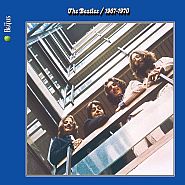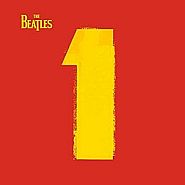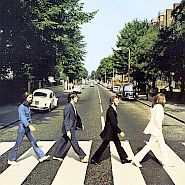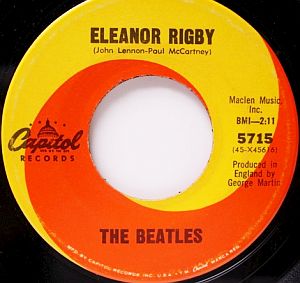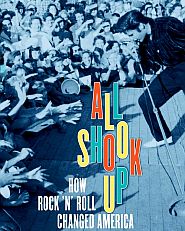The 1966 song by the Beatles, “Eleanor Rigby,” not only became something of an important departure for pop music in its day, it also inspired at least one piece of sculpture in the Beatles’ hometown of Liverpool, England. The bronze statue shown below is displayed at Stanley Street in Liverpool not far from the Cavern Club where the young Beatles performed. It depicts a woman seated on a bench in coat and head scarf with a handbag on her lap and a shopping bag on her right. Also on the bench is a discarded newspaper where a sparrow is pecking at a piece of bread likely provided by the woman as she looks down at the bird. The woman is cast here as of one of the “lonely people,” described in the Lennon-McCartney song, “Eleanor Rigby.”
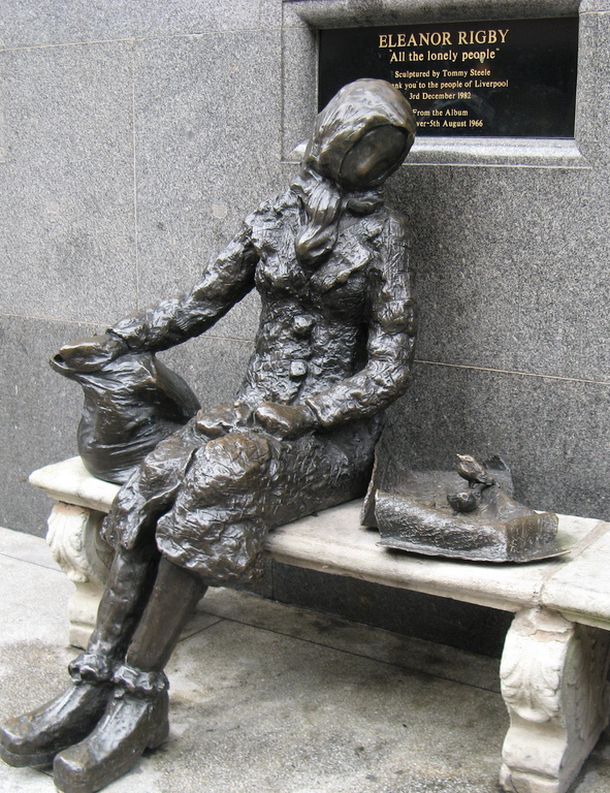
Sculpture in Liverpool, England offered in 1982 in homage to the Beatles’ song, “Eleanor Rigby” and the lyric therein, 'All the lonely people / Where do they all come from.' Sculptor, Tommy Steele.
The statue was designed and sculpted by Tommy Steele, a famous rock musician himself (and sometime sculptor) who rose in the 1950s as Britain’s first teen idol, then dubbed as the U.K.’s answer to Elvis Presley. He is known for his 1957 No. 1 hit, “Singing the Blues.” In 1981, on a visit to Liverpool where he performed, Steele made an offer to city officials to create the sculpture as a tribute to the Beatles, donating his labor. The city fathers approved the idea and also helped fund the project. The cost of casting the figure was met by The Liverpool Echo newspaper. Steele completed the piece in December 1982 when the sculpture was unveiled.
On the wall behind the figure is an inscribed plaque which reads in part, “Eleanor Rigby, Dedicated to ‘All the Lonely People…’ This statue was sculpted and donated to the City of Liverpool by Tommy Steele as a tribute to the Beatles…”
|
“Eleanor Rigby” Ah, look at all the lonely people Eleanor Rigby, picks up the rice All the lonely people Father McKenzie, writing the words All the lonely people Ah, look at all the lonely people Eleanor Rigby, died in the church All the lonely people |
The Beatles’ song “Eleanor Rigby,” credited as a Lennon-McCartney creation, was released on the Beatles’ 1966 album Revolver and as also as single. It appears to be one of those songs, fashioned at least partially, by a group process during the give-and-take of songwriting. In addition to Lennon and McCartney, where the division of labor was 80 percent McCartney and 20 percent Lennon, according to McCartney, several others also contributed suggestions for phrasing and composition that figured into the final song.
Music Player
“Eleanor Rigby”-The Beatles
1966
The idea for the song began with McCartney, who initially had been working with earlier lyrics that he set aside, most of which would be abandoned. But when he hit upon the phrase, “…picks up the rice in a church where a wedding had been,” it became a pathway to the song’s story. McCartney imagined this woman picking up the rice as odd, since others would leave it on the ground. He envisioned her “as a lonely spinster type of this parish,” not likely to have her own wedding, and that’s when he decided the song would be about lonely people. In particular, the song was structured around the spinster and a priest, who presides at the woman’s funeral.
The name Eleanor Rigby came over time as well, with “Eleanor” first borrowed from Eleanor Bron who had appeared with McCartney and the Beatles in the 1965 film Help!. “Rigby” came about from a business sign McCartney had seen – Rigby & Evans Wine & Spirit Shippers. But there is also something earlier from when young Lennon and McCartney first met in 1957, which was near a cemetery at St Peter’s Church in Woolton, a hang-out spot at the time. In that cemetery one tombstone’s engraving includes an “Eleanor Rigby” entry. As McCartney has stated about the name: “It was either complete coincidence or in my subconscious” from his earlier years.
Other lyrics for the song came after McCartney gathered his bandmates together – Lennon, George Harrison, and Ringo Starr, along with Lennon friend, Pete Shotton – at Lennon’s home to help finish the song. George came up with the opening phrase, “Ah, look at all the lonely people.” Ringo contributed “darning his socks,” and Shotton offered that the song should end with a funeral, bringing all the story’s characters together.

The Beatles’ “Eleanor Rigby” EP, Portugal, Parlophone.
In the studio, meanwhile, “Eleanor Rigby” would become a song in which classical strings would be used in innovative fashion, distinguishing this Beatles song as charting new territory. It would be the second time the Beatles would use strings on a song – following “Yesterday,” which features McCartney singing alone with acoustic guitar and string quartet – two violins, a viola and a cello.
Beatles’ producer, George Martin, had first suggested strings to Paul for “Yesterday,” but Paul was initially reluctant. He later agreed to their use, and “Yesterday” would become one of the Beatles’ most popular songs. “Yesterday” had been recorded in mid-June 1965 at the Abbey Road studios in London.
After the experience of “Yesterday,” Paul was more receptive to strings, and some accounts report it was his idea to orchestrate “Eleanor Rigby.” George Martin was quite receptive to the idea as well, later commenting that the song “cried out for strings.” Also at the time, according to John Lennon, McCartney was listening to and liking Vivaldi’s classical masterpiece, “The Four Seasons,” introduced to him by then girlfriend, Jane Asher. Paul though, was concerned about a “too syrupy sound” that strings might add. George Martin, meanwhile, had suggested a more biting strings sound, like that heard in the 1960 Alfred Hitchock film, Psycho. “`Yesterday’ and ‘Eleanor Rigby’ said in one fell swoop, strings can be cool…”– John Reed, cellist.
In any case, two string quartets – comprised of four violins, two cellos, and two violas, scored by George Martin – would become central to “Eleanor Rigby.” The biting sound that McCartney and George Martin sought was achieved with the help of engineer Geoff Emerick who, according to Rolling Stone, “was determined to capture the sound of bows striking strings with an immediacy previously unheard on any recording, classical or rock…” In order to achieve this, Emerick miked the instruments separately and had the musicians sit close to the mics. And the proof, as they say, is in the pudding, as the strings stand out on “Eleanor Rigby” – clearly audible, dominant, and not syrupy at all. The Beatles, however, do not play any instruments on “Eleanor Rigby;” the octet is the only music. McCartney provides the lead vocal, double-tracked, with Lennon and Harrison adding harmonies.
Classical strings had been used in pop music only rarely before, as in 1958, by Buddy Holly, on his single “True Love Ways” and “It Doesn’t Matter Anymore.” Strings were also used in early 1960s pop music by New York city Brill Building composers and songwriters, among them, Gerry Goffin and Carole King (“Will You Love Me Tomorrow?” for the Shirelles), and also Phil Spector and his orchestrated “wall-of-sound” recordings (some with Ellie Greenwich and Jeff Barry), often as background for popular “girl group” songs such as “Then He Kissed Me” by the Crystals and others.
But the Beatles use of strings in “Eleanor Rigby” in 1966, opened a whole new era of studio application. It ushered in the common use of stringed instruments in pop music and helped bridge the then-wide rift between classical and pop music.
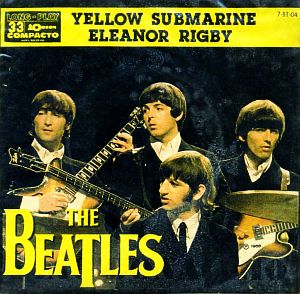
Cover art on the Beatles’ “Yellow Submarine / Eleanor Rigby single as released in Brazil.
“Its impact has been huge,” says Hampton String Quartet cellist John Reed of the Beatles’ and George Martin’s use of strings in the mid-1960s. Interviewed in a 2005 article of Strings magazine, Reed explains: “‘Yesterday’ and ‘Eleanor Rigby’ said in one fell swoop, strings can be cool… Since then, string players have made lots of money being hired to sweeten thousands of rock tracks.”
Message Music
In addition to charting new musical territory, the message and commentary of “Eleanor Rigby” was also covering new lyrical ground. The song was among those that took the Beatles – and contemporary music of that time – away from simple, pop-styled rock `n roll tunes to more sophisticated compositions that had something to say.
“Eleanor Rigby” is described by Rolling Stone as “a meditation on solitude and aging that sounded like nothing else on the radio at the time.” AllMusic critic and reviewer Richie Unterberger has noted that “singing about the neglected concerns and fates of the elderly” on “Eleanor Regby” is one example “of why the Beatles’ appeal reached so far beyond the traditional rock audience”.
After Paul McCartney heard the final track, his perception of his own songwriting changed, according to Rolling Stone, seeing the song as something of breakthrough, moving him away from pop styles toward more serious possibilities in the future.
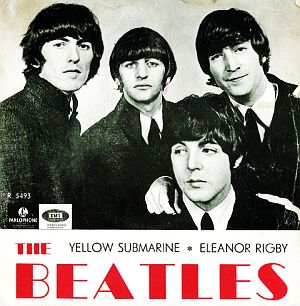
Beatles on the cover of the 1966 Swedish edition of the “Yellow Submarine” / “Eleanor Rigby” single, 1966.
Revolver was the Beatles’ 7th studio album and their second following Rubber Soul, which marked a progression in their new “studio phase” of music making, where they began experimenting with new sounds and new techniques, evolving a more sophisticated body of work (see also at this website a separate story on “Tomorrow Never Knows,” also from Revolver).
In the U.K, the “Eleanor Rigby” single on the Parlophone label went to No. 1, staying there for four weeks. In the U.S., on the Capitol label, it hit No. 11. The song was also nominated for three Grammys, with McCartney winning the 1966 Grammy for Best Contemporary Vocal Performance. Rolling Stone magazine rated “Eleanor Rigby” at No. 138 on its 2004 list of “The 500 Greatest Songs of All Time.”
Beatles song historian, Ian MacDonald, author of Revolution in the Head (1994), has noted that “Eleanor Rigby” – while certainly not the first popular song to deal with death and loneliness – “came as quite a shock to pop listeners in 1966.”
The song, as others have noted, despite its bleak message of depression and isolation with funeral trappings, went right to the top of the pop music charts. Prior Beatles material, for the most part, had been focused on love songs in one form or another. By 1966, they had released a few songs such as “Nowhere Man” and “Paperback Writer.”“…I don’t think there has ever been a better song written than ‘Eleanor Rigby’.”– Jerry Leiber. But “Eleanor Rigby” marked an even sharper departure from their earlier years. Adds AllMusic.com reviewer Richie Unterberger:
… In a broader sense, the Beatles could be commenting here on the alienation of people in the modern world as a whole, with a pessimism that is rare in a Beatles track (and rarer still in a McCartney-dominated one). What are these characters doing their small tasks for, and what is the point: those are the questions asked by the song, albeit in an understated tone. Pessimism about the worth of organized religion is implied in the desolate portrait of Father McKenzie and the finality of the phrase ‘no one was saved.’…
In any case, the musicians and producers of that day were listening, and they heard something new. Pete Townshend of the rock group The Who noted in one 1967 interview: “I think ‘Eleanor Rigby’ was a very important musical move forward. It certainly inspired me to write and listen to things in that vein.” And American songwriter Jerry Leiber has stated: “The Beatles are second to none in all departments. I don’t think there has ever been a better song written than ‘Eleanor Rigby’.” Howard Goodall, an English composer of musicals, choral, and theatrical music has remarked on the song as being an urban version of a tragic ballad with classical Greek influences.

Cover of a 1968 Ray Charles single featuring his version of the Beatles’ “Eleanor Rigby” song. Click for Amazon.
Music Player
“Eleanor Rigby”-Ray Charles
1968
However, one cover version of “Eleanor Rigby,” offered by Ray Charles and his Raelettes (above), provides a strong and vibrant interpretation – adding a touch of soul and R & B from the master, along with a little call-and-response action from the Raelettes. The Ray Charles version, in fact, cracked the U.S. Top 40 in July-August 1968, reaching No. 35.

Cover art for the May 2012 digitally-restored edition of the 1968 “Yellow Submarine” film, which includes the “Eleanor Rigby” song. Click for DVD.
A fully remixed stereo version of the original “Eleanor Rigby” was issued in 1999 on the Yellow Submarine Songtrack for the re-release of the 1968 film. It also appears on several other Beatles collections, anthologies, and box sets issued since the 1990s.
See also at this website “Beatles History” a topics page which includes additional story choices focused on the Beatles, 1962-2015. The “Annals of Music” category page includes other story choices as well. Thanks for visiting — and if you like what you find here, please make a donation to help support the research and writing at this website. Thank you. – Jack Doyle
|
Please Support Thank You |
____________________________________
Date Posted: 31 August 2015
Last Update: 6 February 2024
Comments to: jackdoyle47@gmail.com
Article Citation:
Jack Doyle, “Eleanor Rigby, The Beatles: 1966,”
PopHistoryDig.com, August 31, 2015.
____________________________________
Beatles Music at Amazon.com…
Source, Links & Additional Information
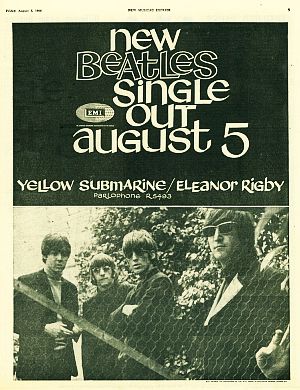 EMI ad on the release of the Beatles’ “Eleanor Rigby” single, appearing in the Friday, August 5th, 1966 edition of the U.K’s “New Musical Express” magazine, which also includes a photo of the Beatles behind a wire mesh fence. |
“The Beatles,” in Holly George-Warren and Patricia Romanowski (eds), The Rolling Stone Encyclopedia of Rock & Roll, Rolling Stone Press, New York, 3rd Edition, 2001, pp. 56-59.
“Eleanor Rigby (statue),” Wikipedia.org.
“Tommy Steele,” Wikipedia.org.
“The Beatles 100 Greatest Songs: Eleanor Rigby, No. 22,” Rolling Stone, Special Collectors Edition (print), November 2010, p. 53.
Song Review by Richie Unterberger, “Eleanor Rigby- The Beatles,” AllMusic.com.
“Eleanor Rigby,” Wikipedia.org.
Greil Marcus, “The Beatles,” in Anthony DeCurtis and James Henke, with Holly George-Warren (eds), The Rolling Stone Illustrated History of Rock n Roll, New York: Random House, revised edition, 1992, pp. 209-222.
“No 138, Eleanor Rigby, 500 Greatest Songs of All Time,” Rolling Stone, 2011.
Terry Cavanagh, Public Sculpture of Liverpool, Liverpool: Liverpool University Press, 1997.
Bill Harry, The Beatles Encyclopedia: Revised and Updated, London: Virgin Publishing, 2000.
Ian MacDonald, Revolution in the Head: The Beatles’ Records and the Sixties (3rd ed.), Chicago Review Press, 2005.
Dave Rybaczewski, “Eleanor Rigby History,” BeatlesBooks.com.
“Document with Clues to Beatles Song Eleanor Rigby Could Raise £500,000,” The Telegraph, November 12, 2008.
“Revolver (Beatles album),” Wikipedia.org.
Miriam Coleman “Sculpture of Eleanor Rigby Made of £1 Million in Bank Notes Unveiled in Liverpool; Life-Sze Statue Is on Display at the Museum of Liverpool,” Rolling Stone, September 21, 2014.
Greg Cahill, “How the Beatles Launched a String-Playing Revolution,” StringsMagazine .com, June 1, 2005.
“Early 60s String Fills,” OrchestraSounds.com.
__________________________________
Books at Amazon.com…
